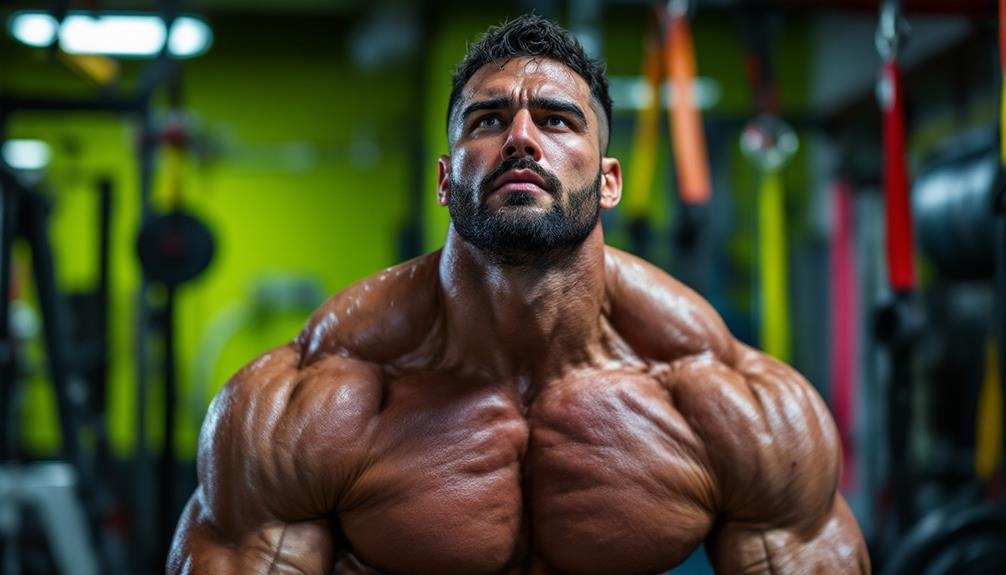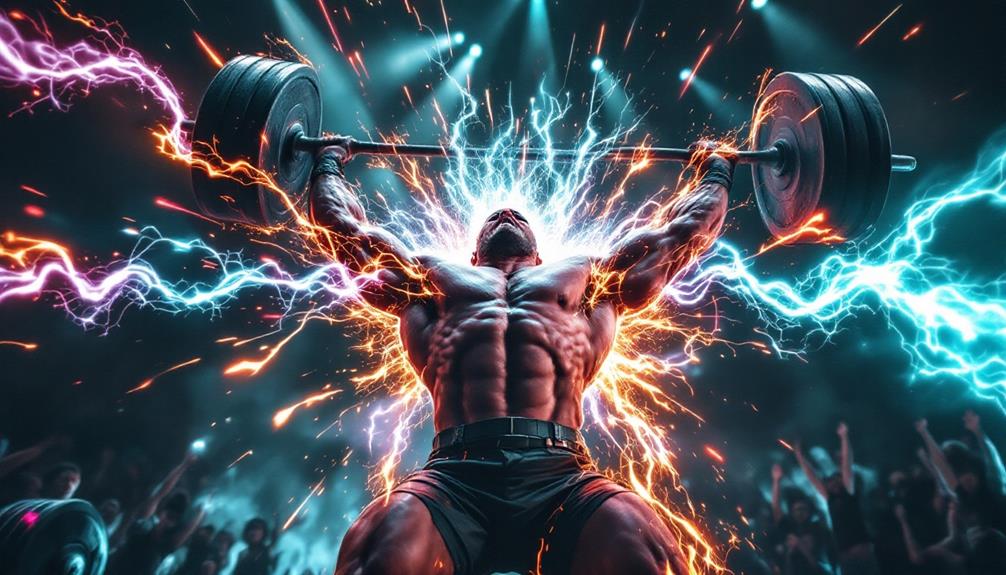Hypertrophy plays an essential role in boosting your powerlifting performance in several ways. First, it enhances muscle endurance, allowing you to lift for longer. Second, you'll experience improved recovery times, letting you hit the gym more frequently. Increased muscle cross-sectional area leads to better stability and balance during lifts. Additionally, better technique and form contribute to safer lifts. Hypertrophy also promotes greater force production, enabling you to lift heavier weights. An elevated hormonal response supports muscle growth, while a reduced risk of injury keeps you in the game. Keep exploring, and you'll discover even more benefits.
Core Insight
- Hypertrophy increases muscle cross-sectional area, enhancing stability and balance during lifts for improved performance.
- Improved recovery times from hypertrophy reduce rest periods, allowing for more frequent and effective training sessions.
- Enhanced force production through hypertrophy results in greater strength output and better coordination during lifts.
- Prioritizing proper technique and form in hypertrophy training minimizes the risk of injury and ensures safe lifting practices.
- Elevated hormonal responses from hypertrophy training support strength gains, muscle repair, and overall powerlifting performance.
Enhanced Muscle Endurance

To boost your muscle endurance, focus on exercises that increase time under tension. This means performing slower movements, especially during the lowering phase of the exercise. Use a combination of low to moderate weights and aim for higher repetitions to effectively challenge your muscles. While some may consider using anabolic steroid alternatives for muscle growth, sticking to natural methods will lead to lasting results without unwanted side effects. You might also want to look into supplements that help with muscle recovery and protein synthesis.
Make sure to include compound exercises that work for multiple muscle groups at once. This not only builds strength but also improves your overall stamina. As your muscle endurance grows, you'll find that your workouts become easier and more effective.
Improved Recovery Times

As you lift heavier weights, your muscles experience stress, leading to small tears that need to heal. Hypertrophy helps these tears heal faster, reducing the time you need to rest between workouts. This means you can train more often and push your limits without increasing the risk of injury.
Using intra-workout supplements can also boost your recovery and performance during intense powerlifting sessions. These supplements supply important nutrients that support muscle repair and growth.
Improved recovery keeps your energy levels high, helping you perform at your best each session. By focusing on hypertrophy, you can create a more effective and sustainable powerlifting routine.
Increased Muscle Cross-Sectional Area

A larger muscle cross-sectional area can improve your stability and balance during lifts. This stability is crucial, especially when you are pushing your limits. Adding premium protein powders to your diet can support muscle growth and recovery, helping you reach your hypertrophy goals.
To achieve this growth, focus on gradually increasing the weight you lift. Include compound movements in your workouts and make sure you eat enough protein to help your muscles repair and grow. By prioritizing hypertrophy, you'll build the muscle power needed for success in powerlifting.
Better Technique and Form

Good technique and form are essential for successful powerlifting. As your muscles grow, they help you lift with more stability and control. This added strength lets you focus on doing the movements correctly, which reduces the chance of injury. Taking glutamine supplements can also help with muscle recovery and growth, which can improve your powerlifting performance.
Having a strong foundation in technique allows you to lift more effectively. When your muscles are well-developed, your body can stay in the right position during each lift. This is important for getting the best results and using the correct muscle groups.
Also, better form helps you notice small changes you need to make during your training. By improving your technique, you can increase your lifting ability and set yourself up for long-term success in powerlifting.
Greater Force Production

Greater force production is important for improving your powerlifting performance. As your muscles grow through hypertrophy, they can produce more force. This means you will be able to lift heavier weights more easily. Bigger muscles have a greater cross-sectional area, which helps increase your strength.
Here's a quick overview of how greater force production benefits your lifts:
| Benefit | Impact on Performance |
|---|---|
| Increased Muscle Size | Higher strength output |
| Improved Neuromuscular Efficiency | Better coordination and power |
| Enhanced Stability | Reduced risk of injury |
| Greater Energy Efficiency | Less fatigue during lifts |
| Increased Confidence | Better mental focus |
Understanding these benefits can help you train more effectively and reach your powerlifting goals.
Elevated Hormonal Response

Getting into hypertrophy training can boost your hormones, which will help your powerlifting performance. When you build muscle size, your body activates several hormones that support strength gains. While natural ways to enhance this response are effective, some lifters might look into testosterone-boosting supplements for extra help. However, it's important to keep a balanced approach to both training and nutrition. Here's how this hormonal boost can work for you:
- Testosterone Increase: Building muscle helps your body produce more testosterone, which is crucial for growth and recovery.
- Growth Hormone Release: Hypertrophy training triggers your body to release more growth hormone, which helps repair tissue and develop muscle.
- Better Insulin Sensitivity: Improved insulin sensitivity means your body can use nutrients more effectively, speeding up recovery and growth.
- Cortisol Control: Good training can help manage cortisol levels, reducing stress and improving performance.
Reduced Risk of Injury

Hypertrophy training helps improve your balance and coordination. This better body control is similar to what you get from compression sleeves, which provide support for specific muscles. When you focus on controlled movements and use proper form, you reduce the chances of making mistakes while lifting. Paying attention to these details helps lower the risk of injuries during heavy lifts.
Frequently Asked Questions
How Does Hypertrophy Training Differ From Strength Training?
Hypertrophy training focuses on increasing muscle size through higher repetitions and moderate weights, while strength training emphasizes lifting heavier weights for fewer reps. You'll build muscle endurance with hypertrophy and raw power with strength training.
Can Hypertrophy Training Be Beneficial for Beginners?
Hypertrophy training's like laying a solid foundation for a house. For beginners, it's beneficial because it builds muscle, improves technique, and boosts confidence, setting you up for long-term success in strength training and physical performance.
What Role Does Nutrition Play in Hypertrophy for Powerlifting?
Nutrition's essential for hypertrophy; it fuels your workouts and aids recovery. You need adequate protein to repair muscles and enough calories to support growth. Without proper nutrition, you won't maximize your hypertrophy gains effectively.
How Often Should Hypertrophy Training Be Incorporated Into a Powerlifting Routine?
Imagine a tree growing strong roots; you should incorporate hypertrophy training into your routine two to three times a week. This foundation supports your lifts, helping you reach new heights in powerlifting and strength.
Are There Specific Exercises for Maximizing Hypertrophy in Powerlifting?
To maximize hypertrophy in powerlifting, focus on compound lifts like squats, bench presses, and deadlifts. Incorporate accessory exercises such as rows and lunges, ensuring you target all major muscle groups for balanced growth.

